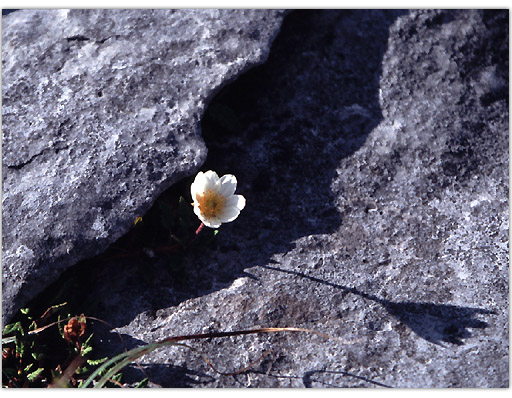November 30, 2003
Ardrahan
Ardrahan is an unassuming little place, a village that one is more likely to be passing through than visiting. There are the ruins of a castle as well as the stump of a round tower. There is a standing stone a few fields away, a marker for an ancient way.
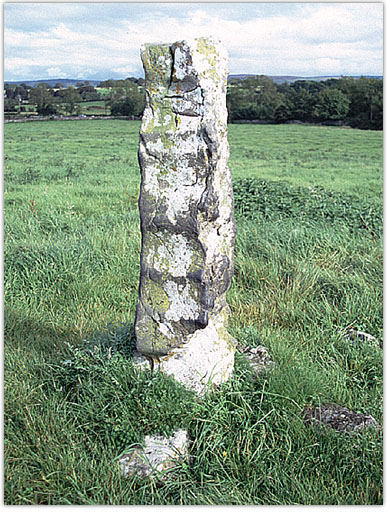
Now, at a stretch, you could describe it as a phallic object. At a stretch. On the other hand, it's difficult to see how else you could describe the rather distinctive stone standing in the field beside the round tower.

I wonder if there is a large statue of a man on his back buried beneath the field, with a huge smile on his face…
On a back road outside Ardrahan, interrupting a line of Scots pine, stands a simple stone memorial. Eighty three years ago this weekend, the bodies of two brothers, Pat and Henry Loughnane were dumped on this road. They had been picked up, worked over and killed by British Army Auxiliaries - Black and Tans.

Pat had been involved in an IRA ambush on RIC (Royal Irish constabulary) policemen a month earlier, in which one of the policemen, a Kerryman, was killed. Their deaths marked the end of a dark week, which began with the morning of Bloody Sunday, when 12 British secret service agents were killed by the IRA. The British Army retaliated by attacking the spectators in Croke Park during the All-Ireland, shooting 12 and wounding dozens more. The day before the Loughnane brothers were killed, Tom Barry led his 3rd Cork Brigade of the IRA on the famous ambush against the Auxiliaries at Kilmichael in Cork , killing 17 for the loss of three of his own men. Such bloody events provide a stark counterpoint to the almost banal election campaign north of the border this week.
November 29, 2003
Rotting swill

You'd feel like this too if you had been dragged to see Love Actually.
In summary
As the year draws to a close, there will be plenty of looking back over the year in the papers, TV and of course, websites. A contributor to the Castlebar.ie site casts a cold eye on the shenanigans in Mayo this year, to nominate his county's Christmas turkeys.
November 27, 2003
Thicker and more absorbant
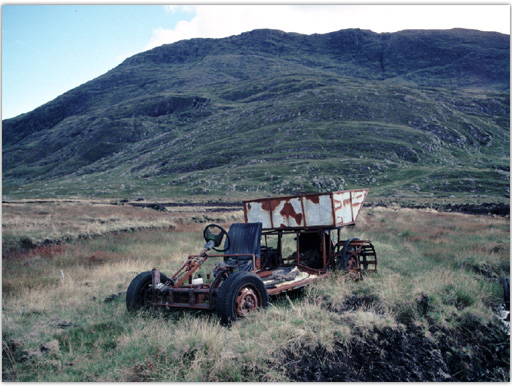
Chariot of the bogs
If one was to write down the recipe for making a bog, it wouldn't take too long, or be too complicated. Find a stretch of land that is not too rich in minerals. Make sure it gets plenty of rainfall. If there are trees, chop them down, so that the rain can get directly at the soil. Let the rain gradually leech the minerals out of the soil, so that the ground becomes poorer in quality. After a while, you'll see Spagnum moss starting to grow. It has an important quality - it can hold many times it's own mass in water - it is literally a sponge. As the Spagnum grows and spreads, the bog begins to form. It begins a self-perpetuating cycle - the already-wet ground prevents other plants from growing. As the moss decays, it forms a mulch that discourages anything other than more moss growing. Soon, the once leafy forest is one large soggy puddle - leave it for a thousand years or so, and you've got a bog (if you want to create that really black, dense turf that burns the best, leave it for 2 or 3 thousand years. If you want coal, push a mountain on top of it and give it another million years).
See, it's easy. One way that you probably wouldn't go about creating a bog is to find an existing bog, dig it up, transport it to a ten acre stretch of another bog, and then dump the first bog on top of it. Well, you might if you were an oil company. Yes, we're talking about the latest chapter in the Bellanaboy story. Last year, An Bord Pleanala overruled a decision by Mayo County council and denied Shell permission to build an onshore station for bringing ashore the natural gas that will be pumped from the Corrib Field, off the Mayo coast. Their objection centred on the plan by Shell to basically bulldoze a large pile of peat into a pile - thus clearing the site. An Bord Pleanala were worried about slippage, and by coincidence, there was a peat landslide just down the road in Pollatomish, and also in Derrybrien since that decision.
So Shell proposed to move the bog. A local campaigner described the plan as lunacy but she was probably just being nice. The problem is that a bog is just like a very large, quivering blacmange, and the thought of dropping one jelly on top of another conjures up the image of a very large and messy splat. The new plan involves 25 weeks, at 400 truck journeys per day, of ferrying peat from the old location to the new. The oil company will probably make billions from the natural gas field - I think they can probably come up with something that won't wash away in the first bout of heavy rain.
Stones in his Pockets
What makes a blockbuster movie? Likeable characters, romance, drama, triumph over adversity, a certain amount of tragedy and poignancy to manipulate the audience, and of course, an uplifting ending. Stone in his Pocket is a play (Town Hall Theatre, Galway, until tomorrow) about the making of such a movie, and the story of the play itself is that of a blockbuster movie. It's success is unquestionable - it has rolled across theatre land like a juggernaut, winning the applause and approval from audiences in Ireland, the West End and Broadway.
This play is about two extras on the set of a Far and Away-type movie being filmed in Kerry - they are both hoping that the movie business will save them from their current lives, and this job is the first step. The movie business symbolises escapism, glamour, achievement. Neither of them seem to notice that all the people they meet who do work in the movie business don't seem to be any happier than themselves.
Plenty of blockbuster movies can transcend a ropey script by virtue of a great cast or slick editing. I'm not suggesting that Stones…. has a poor story but it is not exceptional. Neither is the humour, of which there are lots, particularly original or subtle. No, what makes Stones a great night out is the cast. And despite a large number of characters in the play, they are all brought to life by just two actors. The choreography of jumping from one character to another is exemplary, fully creating the effect of movie editing and sustaining the illusion of the four main, interlocking stories.
The performances by Gavin Armstrong and Denis Foley are delivered with such gusto, that by the end of the play, the stories - of the two struggling extras, the scheming movie star, the harried assistant director and his simpering assistant, and the tragedy of another extra for whom all hope has disappeared, - are as fully realised as if we had been watching a cast of many. It is a great show.
Incidentally, we had dinner in Mcswiggins beforehand (which alas, we had to wolf down to make the start of the play), and the place was jammed. On a Tuesday night. Recession? What recession. Dinner was great, BTW.
November 25, 2003
Gift Horses
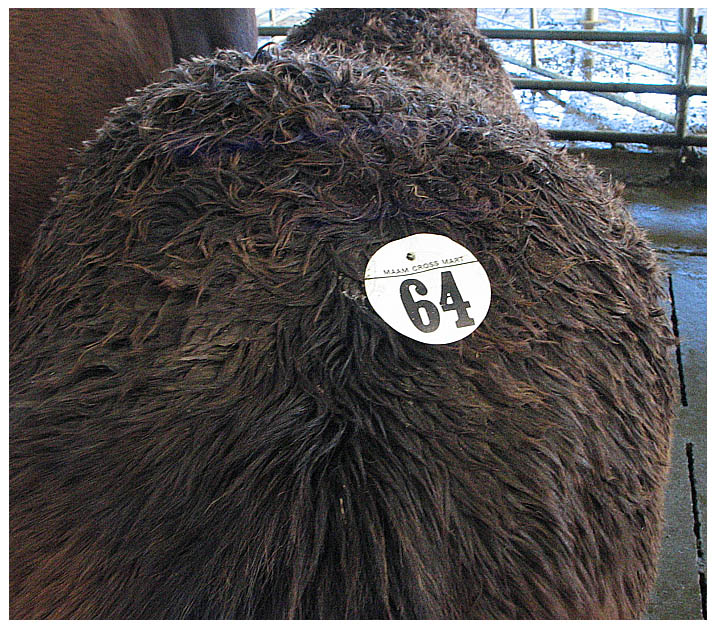
Louis XIV, the Bourbon prince believed that he would be reincarnated as a horse, and ordered a huge set of luxurious stables built in Chantilly for his future comfort. Whether it was the appeal of a life of green salads for lunch or spending his afterlife with bewigged effetes strapped to his back that formed the basis of this belief is not recorded.
Meanwhile, in the UK, some managers and executives are going on horse-whispering courses. Ostensibly to improve their communication and leadership skills, clearly one can be taken for a ride without actually getting on a horse. The article doesn't mention which end of the horse the captains of industry were talking to.
There was a sale of Connemara ponies in Maam Cross on Sunday. The going seemed to be slow, and not much money was changing hands. There was never any doubt of who would be going home in the horsebox, mind. A few pics here.
November 20, 2003
Stardust

Aurora in the western sky
If you're reading this on Thursday night, get up now, go outside and stare at the sky. There is a wonderful aurora in progress. According to the Astronomy Ireland email alert,
The aurora was caused by a CME (coronal mass ejection) from sunspot group number 484 that has survived a complete rotation around the back of the Sun and is nicely on view again.
At one stage, there was a massive red filament arcing right across the sky from the eastern horizon to the west . It was simply awe-inspiring, and beyond the ability of either my camera or myself to capture its beauty. This is the second time in a month that we've had a celestial display - if there's a spate of births in nine months time of blue-eyed, blond babies with telepathic powers, we'll know what caused it.
The CME happened two days ago. This photograph was taken an hour ago and has not been processed or adjusted - the exposure was 15 seconds at F2. It was taken with a Canon G3 digital camera, which is a recent purchase. It is better equipped than my EOS SLR camera and the quality of the images is fantastic. Yes, it was a bit pricey, but deep down, I know Herself didn't really want a holiday next year.
UPDATE 24th November: I 've posted a small gallery here.

Dust thou art, to dust returnst. Aurora in the eastern sky
This photo was taken looking towards the east, in a local graveyard. When I suggested to Herself that she might..um..like to keep me company while I set up among the headstones, her response was (roughly) "are you mad - a graveyard? At night?" Curiously, she had no problem with me traipsing around the graveyard, where I slowly froze. To make matters worse, one of the legs fell off my so-called indestructible tripod (a Benbo) - the bloody thing is only 9 years old.
November 16, 2003
No direction home
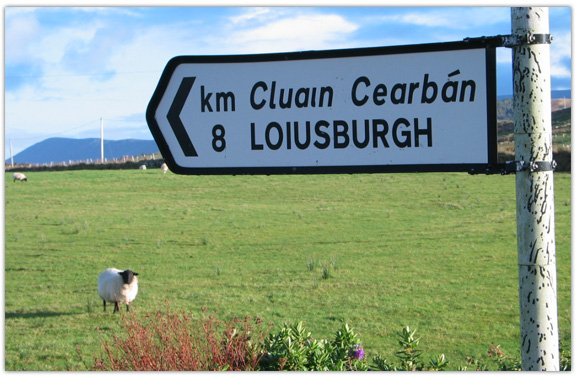
It's one thing if visitors pronounce the name wrong, but this is just messing, lads...Sign for Louisburgh in Kileen, Co. Mayo. Photo taken November 15 2003.
Coming ashore
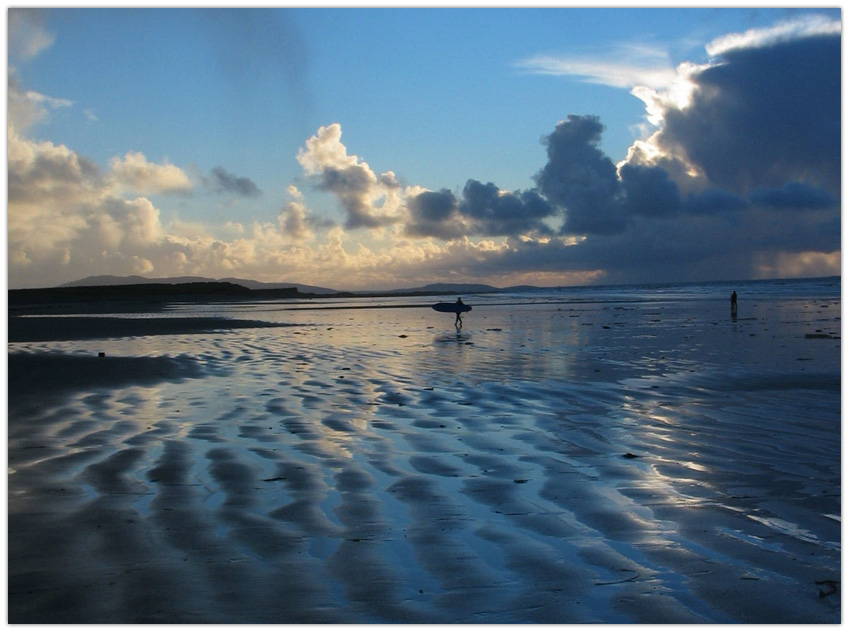
Surfers from the Delphi adventure centre in Mayo come ashore at sunset. And, yes, it was bloody freezing. Photo taken at Bunlough Strand, Co. Mayo - November 15 2003
Big Air
Duncan Stewart, broadcaster and environmentalist, is lucky to be alive. He was filming around Chernobyl in Belarus recently when he took a fall, broke ten ribs and punctured his lungs. He is slowly recovering back in Dublin and Wild on One, the Radio One wildlife programme visited him in hospital this morning. Duncan spoke passionately about wind energy, pointing out that there is the potential to provide 25% of Ireland's energy needs from wind energy.
The issue of Derrybrien came up - as he pointed out, he comes from just down the road - and immediately, the witless presenters piped up "NIMBYs!" - the gist of their argument (if you could call it that) that if only the country folk stopped objecting to wind turbines, we could be living in a clean energy paradise. Alas, if they had done even five minutes research on the subject…
Germany produces 50% of Europes wind-generated electricity - Denmark is close behind. There are generous EU grants for erecting and producing wind electricity. However, if you have ever been to either of these countries, you'll notice something. The wind turbines are not just hidden away in remote country areas. They are either built off-shore (the really big ones) or they are placed pretty much anywhere. I guess the thinking is that since the landscape, including the urban landscape, is already impacted by human development (electricity pylons, chimneys, etc.) so the odd turbine in the suburbs won't make much difference. Somehow, I reckon that if there was a proposal to build a few turbines in Dalkey, Bray, the Strawberry Beds or Bull Island, the Wild on One crew would change their NIMBY tune pretty quickly.
Wind energy poses something of a problem for environmental activists. Though the source of energy may be clean, the construction of the wind-farms is just as destructive as any other major industrial operation. The same people who complain about ribbon development of houses 'ruining' the countryside seem to have no problem with a massive wind-farm having an even bigger visual, and sometimes environmental, impact on the same landscape. Funny that, eh?
It has still not been officially proven that the wind-farm construction at Derrybrien caused the landslide, in the sense that a huge area of bog might not necessarily be impacted by repeated explosions nearby for quarrying, the incessant drilling of two-storey sized holes for the turbine shafts or the non-stop traffic of ten-tonne trucks ferrying building materials on-site. It could be just a co-incidence. Funnily enough, the Connacht Tribune reported this week that, when Galway County Council approved the County Development Plan (which designated 130 square miles of Galway fit for wind-farm development), the Irish Peatland Conservation council warned about the prospect of damage to the environment. Not that anyone paid much heed to it at the time.
By coincidence, there was a renewable energy conference held in Sligo this weekend. The 'wind' industry professed themselves happy at the reaction of local people when any new wind-farm was planned - the minister, Dermot Ahern, stated that Derrybrien would act as a guide for any future project (presumably, as in 'what not to do').
November 15, 2003
Windswept
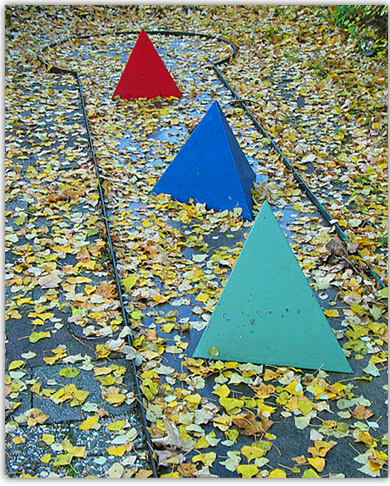
A few more days like the previous ones and there won't be many more leaves left on the trees. More rain and gales predicted for the weekend.
November 11, 2003
The Eleventh Hour
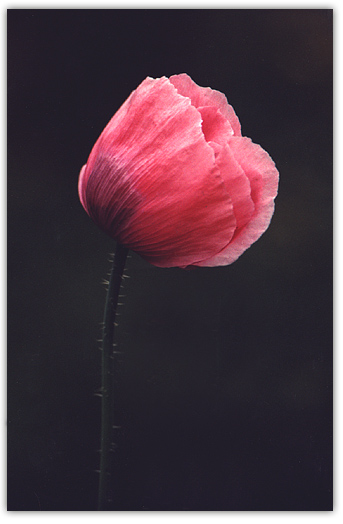
I came across the Clare Library website today - it is really excellent, both well-designed and loads of local information and history. Every county should have a similarly constructed page. One of the pages contains a list of every north Clare man who fought and perished in World War 1.
Today is Remembrance Day, or Poppy Day (or Veterans Day), which was originally instituted to mark the end of World War 1 (the war to end all wars) but now also commemorates the dead of many other wars since. In Ireland, commemorating the dead is proved somewhat problematic - given the historical grudge with our nearest neighbour, honouring Irishmen who fell wearing a British uniform had become something of a rarity (though not always, as this history of the Royal Dublin Fusiliers records). In recent years, there has been a rapprochement - the Peace Process and Ireland's increasing self-confidence as a nation has enabled people to commemorate the sacrifice and honour of the fallen soldiers, irrespective of the flag or cause for which they fell.
It could not be any other way. The Irish are a wandering race, and have fought and died all over the world; from Patrick Sarsfield, the Little Big Horn, the Two World Wars to even the latest conflict in the Gulf, when Dubliner Ian Malone was killed while serving in the Irish Guards.
The historical ambiguity, and the lingering wound of The Troubles has meant that the state does not celebrate in a meaningful way those who died in an Irish uniform - for all the holy days and bank holidays in this country, there is not one that honours those who fought and died for Independence or as part of a United Nations action. Perhaps we will know that this nation is truly at peace with itself when those Clare men who died in French and Belgian fields are honoured alongside those who died under an Irish flag, and those who would pay their respects did so not as a political gesture but as a simple act of veneration.
The photo of the poppy was taken in 1995 at the site of the Bergen Belsen deathcamp, in northern Germany. Yet another example of the madness that beset a nation, it was the logical conclusion of a political philosophy that demonised the 'other', the 'different', the 'abnormal', the 'foreign', the 'impure'. There was no scientific approach to killing in this camp. Jews, homosexuals, left-wing activists and other 'undesirables' were interned in one side of the camp - Russian POWs were kept in the other half. Both sides were simply neglected, so that the inmates starved to death. When the camp was liberated, the soldiers burned it to the ground, and quickly buried the mounds of the dead to prevent the spread of typhus which was rapidly killing the survivors. Only a few small hills, a meadow and a few plaques remain.
November 09, 2003
Fore!
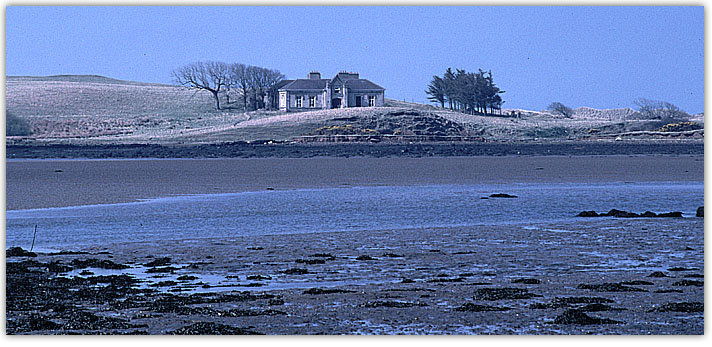
The people of Killala have a new celeb neighbour…maybe. Nick Faldo is supposed to have bought Bartragh island. Basically, the island is a large sand dune with a house on it, and it is located in the middle of Killala bay, within view of the abbeys of Rosserk and Moyne . Which would make for a very tricky golf course (tiny green, huge bunkers, and one hell of a water obstacle)…which is what Nick has apparently planned for the island.
However, there may be a problem, since Nick might not have actually bought the island from the owner (i.e. he bought it from someone…just not the person who owned it).
Land Movement
Well feck it. Somehow I managed not to get a single photo of the aurora last week. Last night, I had high hopes of taking a few snaps of the lunar eclipse, but cloud cover put paid to it. Mind you, I might have missed it anyway. The eclipse was visible between 11pm and 1am, but blazing fire + comfy couch + couple of glasses of wine = very sleepy photographer. I slept through most of it. Anyone who is worried that the eclipse is a harbinger of something worse will have some fun with this list.
Given all the news of landslides recently, it seems like good timing that there is a public lecture on earthquakes in Galway (NUIG) on Tuesday.
November 02, 2003
Boffins
There's a new Irish science magazine on the market, called Science Spin. It's a nice glossy publication, with plenty of interesting articles. The cover story is about a project by the Marine Institute to photograph the entire Irish coastline. The result is 10,000 images on 8 CDs. (Though it's not mentioned in the article, each CD costs 31.50 euro and there's one each for Galway and Mayo. Clare and Limerick on the same CD, as are Sligo, Leitrim and Donegal). In addition to the cover image, there are two pages of photographs showing various parts of the Irish coastline. However, only photograph has a caption that describes what you are actually looking at. Which one ? You guessed it - the Dublin picture (of Sandymount Strand). The rest are labelled simply as "Mayo", "Clare", etc. Looking at photographs without knowing where it is has limited appeal. The pleasure is in seeing something familiar as if for the first time (the images are shot in infra-red, so green objects like grass and trees show as red in the images). Even the cover image of Galway city gets no caption, though you can see the Cathedral, the salmon weir and the university. So is this yet another case of jackeens just not bothering ? Well, probably not. The magazine is published in Foxford, Co. Mayo. The images on the CDs are labelled - it's looks like the magazine just didn't bother. Try a bit harder the next time, lads.
At the back of the magazine is a list of academic projects that received funding from the Science Foundation Ireland. One in particular caught my eye (from the University of Limerick).
…studying the design, deployment and evaluation of novel interactive artifacts and environments in public shared spaces based on a human activity conceptual model.
Eh? This could about two farmers trying to chase sheep back through a gap in a stone wall using new sticks cut from the ditch. Though I doubt it.
What are they feeding them?
Frank Zappa warned about eating the yellow snow. Thomas Delaney was nearly floored by a chunk of blue ice that landed near him, as he walked through Ballybrit racecourse in Galway. It had come from a passing plane. He is keeping a lump of it in his freezer as evidence (I hope it's not too close to the burgers). Just as well it didn't fall during Race Week. Full story in the Galway Advertiser.
After the Mudrush
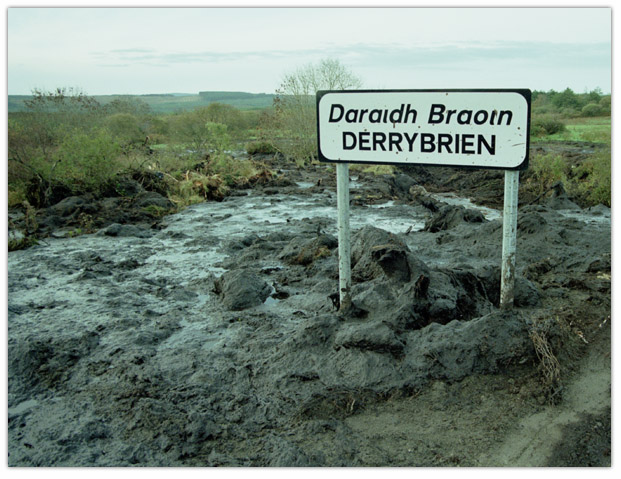
It was reported in the papers during the week that 550 animals were killed in the landslide at Pollatomish - the cause of the landslide has still not been established. Meanwhile, I paid another visit to the scene of the Derrybrien landslide yesterday morning. It is not a pretty sight. When I was there two weeks ago, the slide had been halted before a bridge on the bog road at Derrybrien north. since then, the slide resumed, overwhelming the bridge, and continuing down the hill. About 300 metre downhill lies the R353, the road linking Portumna to Gort. The flow of peat slurry followed the path of a stream and it hit the road at a bridge completely smothering it, and continuing down into the valley below.
Earlier today, the clean-up operation was underway. The two roads have been cleared, but the damage to the hills, fields, and more importantly, the water system is incalculable. The escavations are being done by a combined team from Galway County Council and Hibernian Windpower, the company building the windfarm in the area. It looks like there is a two-pronged plan to tackle the problem. Firstly, scoop out the peat slurry from the affected streams and drains to minimize further pollution, and get the drainage system of the area working again. The other part of the plan is to erect a series of barriers (or dams) to try to halt further slides.
The barriers haven't worked so far. Not because they aren't constructed properly, but simply because they are not high enough. Well, why not build them bigger ? Between the the bog road and the main road (which were both inundated), there is a drop of more than 30 metres (to give it some perspective, the height of the round tower in Kilmacduagh is 35 metres, and the top of the dome in Galway Cathedral is 45 metres tall). OK, well why not build barriers further up the hill, near the start of the landslide. The entire area from where the slide began covers about 70 acres (about 28 hectares or 283,500 square metres). What's needed is not just a few piles of boulders and gravel damming up streams but a plan to stabilise the whole area - to prevent a gigantic glutinous mass converting potential to kinetic energy by detaching itself from the hillside and trundling down the hill at speed, smothering all in its path.
Stabilising the bog won't be easy. We are now definitely in the rainy season. there has been relatively little rain in the last two weeks, but yet the slide intensified. What will happen when there is a bout of prolonged rain ? Since I left the site yesterday, it has rained heavily. Yesterday, there was a constant stream of trucks along the back road, moving gravel to build an access road, so that escavators can begin building barriers near the origin of the mudslide. Even this level of disturbance will not help matters...
I've spread the photos over three entries to speed up the loading times - the image files are larger than normal (circa 150k each) for better detail.
The follow photographs were taken at the bog road, which is about 30-40 metres above the village.
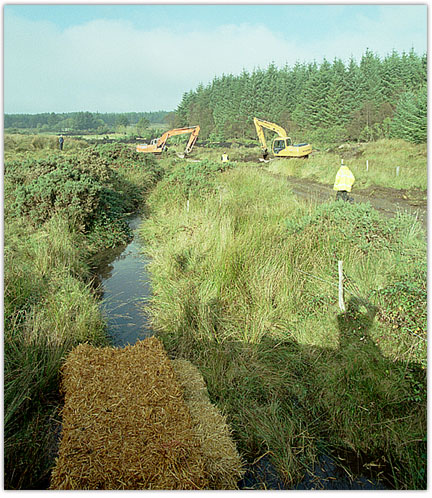
Two weeks ag, the mudslide had halted at the point where the escavator can be seen.
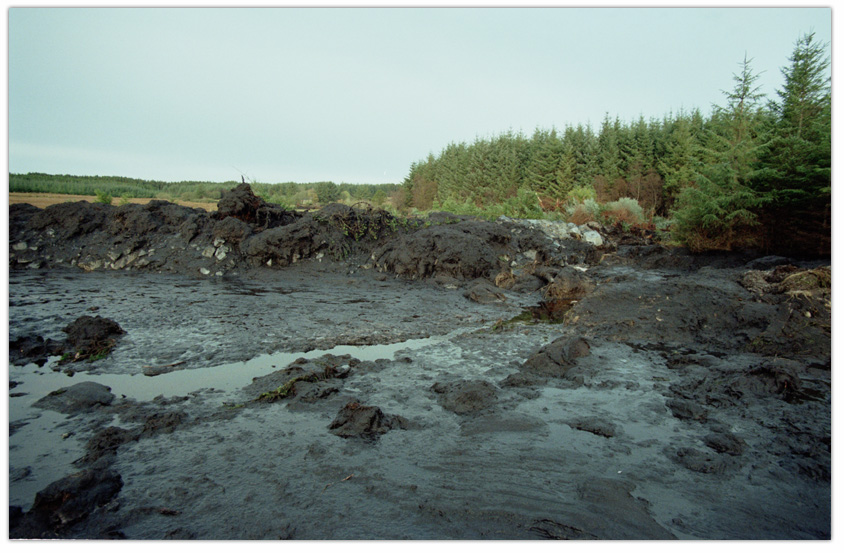
Two weeks ago, the slide was quite a distance from the bridge - now the rampart has been swept away, the bridge has been completely choked with debris, and debris lies at least one and a half metres of debris above the level of the road.
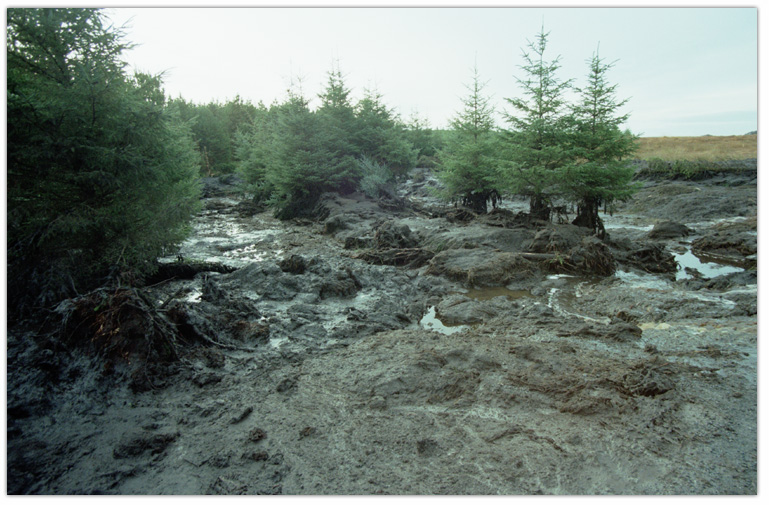
The view on the other side of the bridge isn't much better. Instead of a small stream gushing between the pine trees (on the right of the picture below), there is an ugly ditch where the diggers have tried to scoop out the slurry. In the centre of the picture, there should be a row of trees, the slurry bulldozed them out of the way, on the way down to the main road.
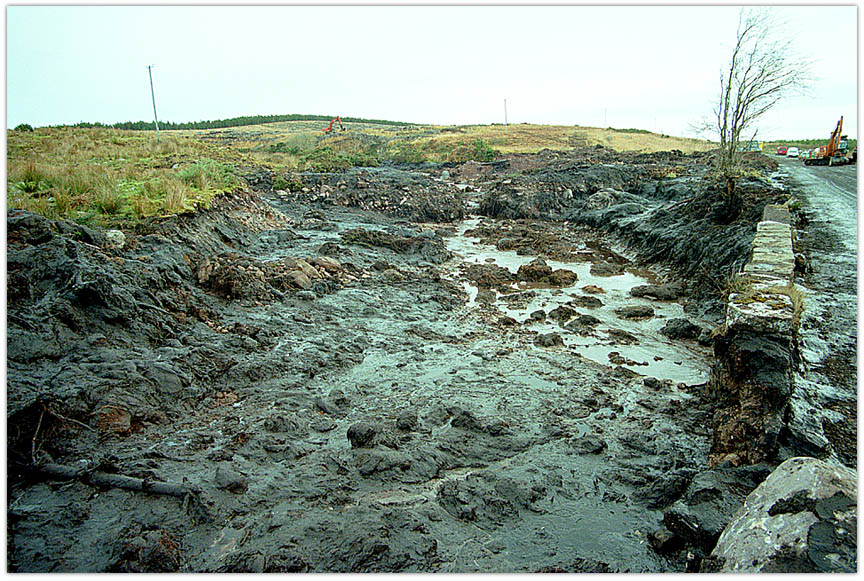
On the main road (R353), a row of boulders were placed beside the rampart of the bridge, in an attempt to dam the flow. Made no difference - the flow simply went over it. As you can see, the bed of the stream is 8 to 10 feet below the level of the road at the bridge.
After the Mudrush II
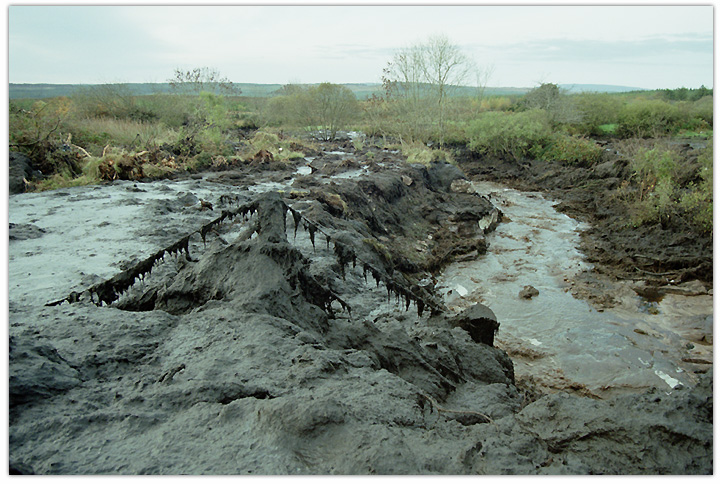
The slurry continued down the valley, choking up bridges as well as the life of pretty much anything bigger than pond scum in the water.
This stream is a tributary of the Owendalulleegh River (Abhainn Dá Loilíoch - means river of the milch cow, I think) which flows in Lough Cutra. If the flow of mud continues for a prolonged period of time, the people of Gort will be drinking bottled water for a long time.

The map shows how close the main part of the landslide has come to the Owendalulleegh River. Though the news reports mention the fact that the village is beside a 1000 foot mountain, the landslide started at around 310 -320 metres altitude in Derrybrien north, and has travelled about 2 kilometres to an altitude of around 120 metres (this is just rough guessing from the OS map). As you can, the drainage system of the area leads eventually to Lough Cutra, which provides drinking water for the town of Gort. Next year, it is planned to extend the water supply to the regional areas around Gort, requiring an increase in pumping from 6000 cubic metres to 7500 cubic metres per day.
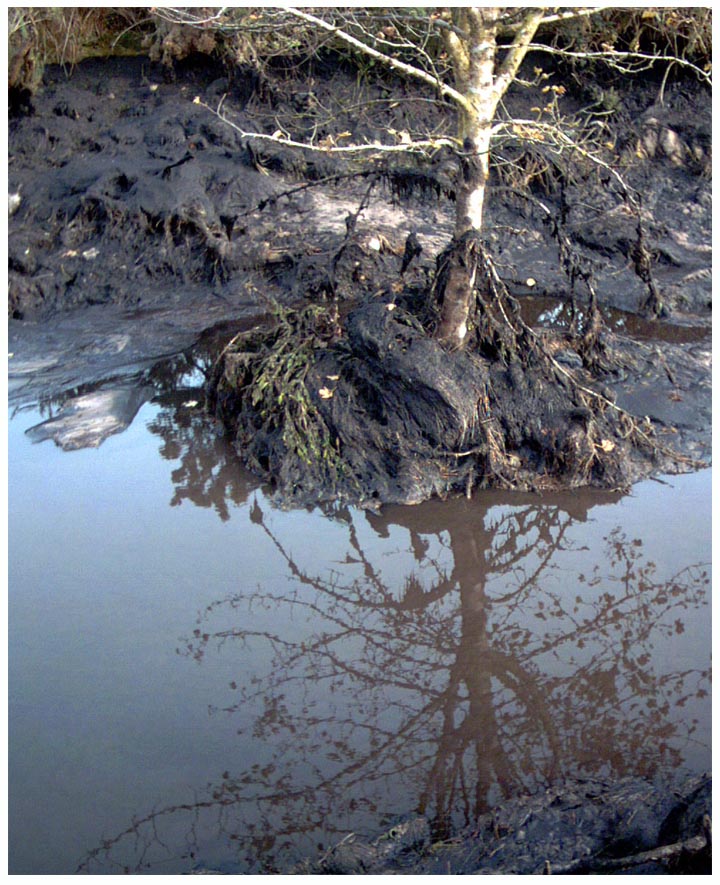
This image would be normal in a swamp in Louisiana. It's not so encouraging in a hillside stream in south Galway.
After the Mudrush III

Here's a tip; if you're wandering around drains full of slurry, don't fall in. Ich bein ein gobshite.
It was almost the perfect pratfall. I had just clambered across on of the makeshift dams built to contain further flows of slurry. When I got to the far side (the foreground in the picture below), I stepped off the embankment onto what I thought was the solid ground of the gravel road (there was a tractor parked on it so it seemed solid). PLOOMP - for a split second I wondered when exactly I was going to hit the bottom. It was waist deep. I was stunned - I couldn't have been more surprised if the Invisible Man had strolled up to me and gave me a kick up the arse. Instinctively, I raised my arms up to save my camera (which did survive) - of course, when you're falling forward, raising your arms doesn't help. At least I kept my mouth shut.
The best part was that I still had another 45 minutes of walking around to do (I was on my way down to photograph another bridge). At least I cheered up some of the workmen who had a good laugh. Mercifully, the only two witnesses were two small boys sitting in the tractor. Cute as buttons, they nearly fell out of the cab laughing at me.
I drove home in a state of undress. It occurred to me that if I hit a sheep on the way home, and I had to get out of the car to clear it, and someone came along...I think the judge would just throw away the key...

This dam is downstream of the R353 road.
And finally

Bad luck happens in threes. Sign of exasperation near Derrybrien church. The 1999 reference is to the designation of bogland at Derrybrien as a Special Area of Conservation, restricting turf cutting. Here is a reference to the controversy from a Dail debate in 1999 (half way down the page).
I never thought I'd see slurry tourists, but there has been a constant stream of visitors to Derrybrien, particularly today (though there is very little to see, since there are county council workers preventing people from wandering about). However, the drive from Gort to Derrybrien is quite beautiful, now that the beech and yew trees are glowing yelow, gold and russet. If you are going down there for a gawk, be sure to look around the woodland. The area around Lough Cutra is particularly beautiful.
